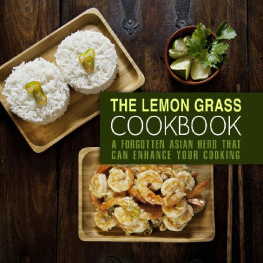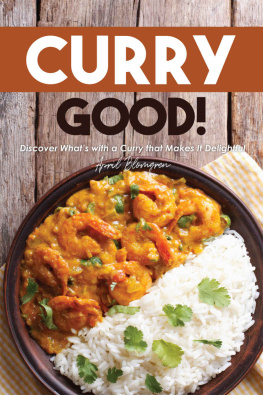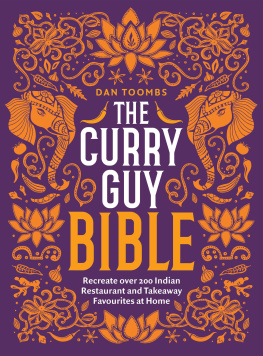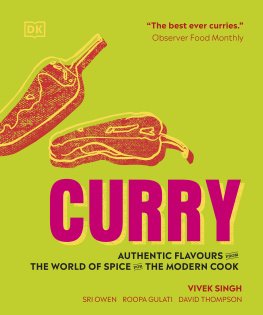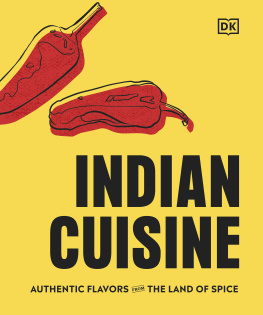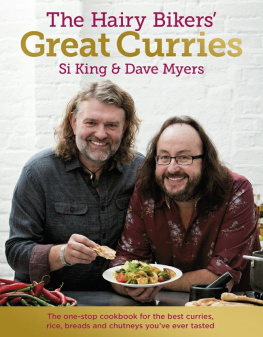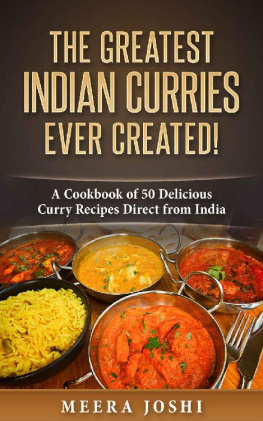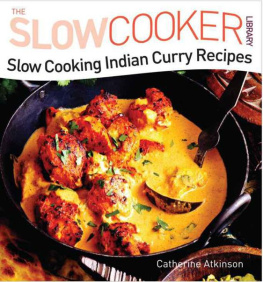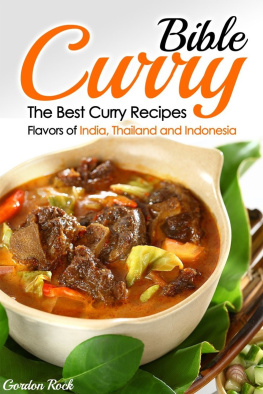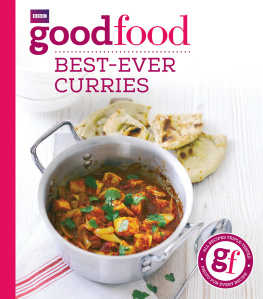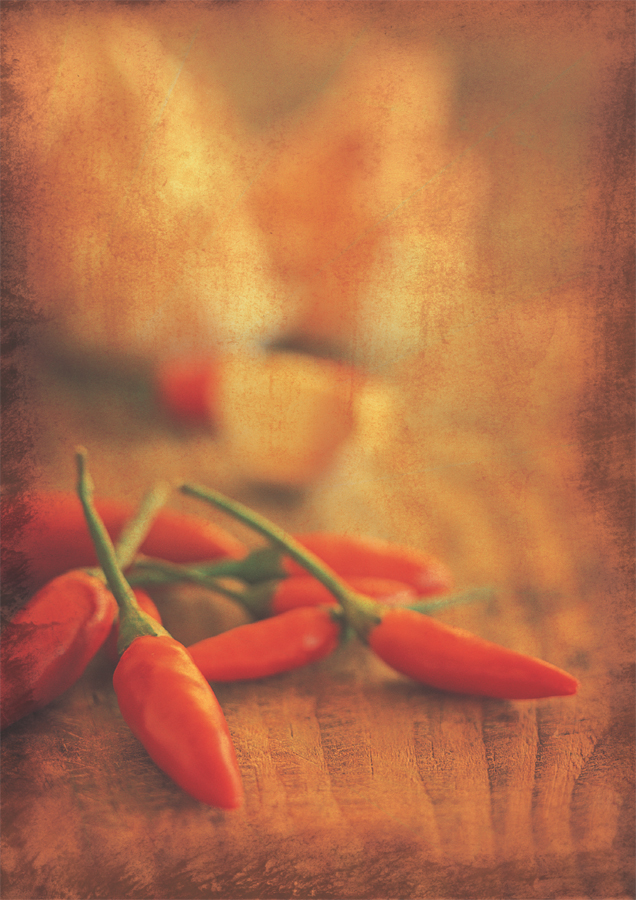The Little Curry Cookbook explores the delicious flavours, enticing aromas and exotic colours of curries. It celebrates the best loved Thai and Indian dishes as well as introducing lesser-known, but equally delightful, variations from Indonesia, Sri Lanka, Malaysia and Kenya.
There are recipes for all occasions and for all levels of expertise, including techniques for perfecting the basics of curry-making preparing curry pastes, creating spice mixes and, of course, cooking rice.
C ontents

B ring alive the flavours of curries:
rich, earthy, hot and sour, aromatic, or softly sweet. I nfused with fresh, leafy herbs and fragrant spices, curries are much more than simply hot or spicy.

For such a humble sounding word, curry refers to some of the worlds most delicious and popular dishes. The word itself was first coined by the British in India, possibly deriving from the Tamil word kari, meaning spiced sauce. Today the term covers dishes that range from simple to sophisticated, complex to singularly bold, those that can be made in minutes or left for hours over a bed of coals, and includes the everyday food of peasants to the once-exclusive creations of the rich and royal.
U se of the word has expanded to include the curries of Southeast Asia alongside those of India, and this book features dishes from cuisines as varied as those of Kashmir, Goa, Bangladesh, Thailand, Malaysia, Sri Lanka, Laos and Vietnam. Despite this diversity, all curries share a few essential elements: a curry paste, seasonings which can vary from fresh herbs to pungent shrimp paste and the main ingredient, such as meat, fish, pulses or vegetables. From there, curries can go in many directions. They may be dry, oily, wet, thick or thin. The cooking can involve frying, boiling, steaming or slow, gentle braising. Adjectives such as sour, salty, hot, sweet, creamy, pungent and fragrant may all be applied to a finished dish, more often than not in combination. In fact, if anything unites curries, it is their skill in blending various tastes, textures and aromas to create superb dishes of great depth and balance.
The essential starting place is the curry paste. The paste will infuse the other ingredients with its flavour and fragrance, and its creation is a real part of the pleasure of making a curry. Traditionally, curry pastes are made by hand, the ingredients added one-by-one to a mortar for grinding or to the frying pan for roasting, with the cook observing, smelling and adjusting as necessary. Buying prepared spice mixtures is convenient, but to experience the real thing, have a go at preparing one from scratch.
Of course, the other thing that unites curries is rice. This staple of life is central to the cuisines of India and Southeast Asia, and curries are there to support the rice not the other way round. Once again, the trick is to seek balance, combining delicately perfumed rice with vegetable dishes, side dishes and curries to match. This book contains some classic raitas, pickles and breads to experiment with and many more wonderful curries that amply demonstrate the delight to be found in this age-old dish.
RICH CURRIES
Creamy, smooth curries are often the best place to start if new to curries. In fact, many of the worlds favourite curries belong to this type the most common examples include butter chicken, Thai Massaman beef curry, Indian lamb kormas and the many kofta, or meatball, recipes that are served resting on a bed of rich, creamy sauce. These curries have coconut milk, ground nuts, yoghurt or cream as their base, sometimes singly but often in combination.

Coconut is perhaps the most versatile of these products. It harmonises flavours, subdues the potency of fiery chillies and balances sour ingredients such as Thai apple eggplants (aubergines), tart lime juice and salty shrimp paste. The taste of the coconut itself is also important. Fresh coconut cream, in particular, enriches the curry with its own depth of flavour, so that dishes are complex and sumptuous not merely creamy. Tinned coconut cream does not have the same qualities as fresh coconut but is much easier to obtain. Every part of the coconut tree is used, from thatching for houses to making lotions for the skin and hair from the oil. In India, coconut forms the basis of golden, thick korma-style curries, perfected by the Moguls in the seventeenth century, as well as the yoghurt-based dumpling dishes of Gujarat and the spicy seafood curries of coastal Goa. Thai uses of coconut are just as varied and delicious. Their spicy red curries, the sharp green curries and the panaeng and Massaman curries of the south all have coconut as their starting point.
In contrast to coconut, yoghurt is more often used as a thickener and tenderiser of meat than as a flavouring, producing wonderfully tender, slow-cooked curries of lamb and beef. It is also the key ingredient in soothing Indian raitas, for which many of us have been thankful.
EARTHY CURRIES
The pleasure of many curries begins with the aroma that is released at the start of cooking, as dried spices roast and crackle in the wok or pan. This is especially true of the earthy curries. Spices such as cumin, fennel, coriander seeds, turmeric and curry leaves all bring a warm, rounded, toasty aroma and flavour to curries. For these curries, aroma is of equal importance to flavour and texture.
Taking the time to grind and roast your own spices may seem like a luxury but it is one of the best, and most enjoyable, ways to learn about the different qualities of the spices that go into a curry. Coriander seeds, for example, have a sweet, heady aroma, suggestive of pine and pepper, while warm and bitter cumin is immediately distinctive. Fennel seeds have a subtle anise aroma and warm, sweet, intense flavour that mellows on roasting. Different again are potent cloves, with their sharp and woody flavours contributing to many curry powders, and versatile, pungent turmeric. Hidden within the unassuming dull brown skin of this root is a vibrantly coloured golden interior that, as a ground powder, is used in countless curries to balance and enhance the other flavours.
Earthy curries share a depth of sensuous flavour and aroma that is not always anticipated which makes cooking and eating them all the more enjoyable.






